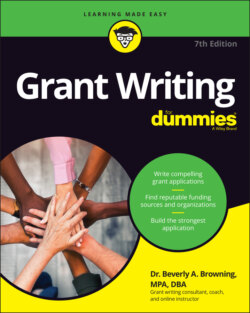Читать книгу Grant Writing For Dummies - Stan Hutton, Beverly A. Browning - Страница 42
Looking for needles in a haystack
ОглавлениеTo identify as many potential grantfunding sources as possible for your organization, you need to carefully research the primary sources of funding: the public sector (federal, state, and local government) and the private sector (foundations and corporations).
As you read information on each funder, you see few, if any, funders want to receive a grant proposal without any warning from the applicant. For many, you need to, in a sense, be invited to submit a full grant request after you’ve met each funder’s initial contact requirements. That’s why your initial approach (your first contact with the funder) is so important.
Review each funder’s initial approach preference using their website or funding database subscription to find what initial contact or approach document they require. In Chapter 6, I tell you how to find private-sector funders and mine the right information. You can find more information regarding these documents in the later section “Using a letter of inquiry or intent to comply with pre-application guidelines.”
Focus on finding open or current grantfunding opportunities first. Then you can print out expired notices and contact the grantmaking agency to see whether the funding will be available again in the future.
Create a day-to-day work plan to monitor a project that will require multiple funding requests. When you’re juggling multiple funders, developing a work plan using a table or spreadsheet format and plotting this information, as I show in Figure 2-2, is a good way to stay organized and on top of everything. Your work plan is an extension of all the details plotted out in your funding plan. The work plan is an ancillary document to track all potential funders for one program. Make sure the funder number listed on your table matches up with the correct grant proposal. Also, as you move through the application process, fill in the last two columns on the right-hand side. In the status column, you can enter: writing scheduled, writing in progress, submitted, and pending decision. For the outcome column, you can fill in funded or rejected when you know.
Illustration by Ryan Sneed
FIGURE 2-2: Make a chart to track multiple potential funders for one program.
